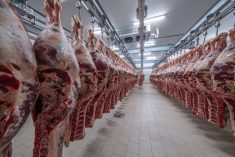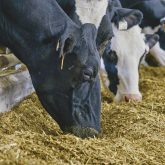Alberta Farmer Express — As Alberta’s hog industry braces for the seemingly inevitable arrival of porcine epidemic diarrhea (PED), the province has announced an early opening to a program to boost on-farm biosecurity.
“Even though we do have some connections with feed now, biosecurity is still our best tool in preventing the spread of PED,” said Dr. Julia Keenliside, veterinary epidemiologist with Alberta Agriculture and Rural Development in Edmonton.
The province is reopening the animal health biosecurity programs that are part of Growing Forward 2. The next round of funding was set to start April 1, but has been opened earlier; the cap for funding has now also been raised to $150,000, up from $30,000.
Read Also

Ample supplies and improved livestock sector to boost Canadian feed sector: FCC
Abundant feed grain supplies and improved profitability for the livestock sector should support strong feed demand and sales through the winter, says a new report from Farm Credit Canada.
“Because PED is here to stay in North America, we have to make long-term changes to our biosecurity,” said Keenliside.
“This will allow producers to get more quickly onto the application process and start improving their biosecurity on the farm.”
The first case of PED in Canada was found in Ontario on Jan. 22, and the virus has since been confirmed on 27 farms — 24 in Ontario and one each in Manitoba, Quebec and Prince Edward Island. Traceability has played a critical role in finding the source of the virus in these cases — and in preventing future ones, said Keenliside.
In the first reported case in Manitoba, a trailer with Alberta hogs on it had unloaded at the same place as a trailer from the infected farm several days before the disease was confirmed on the farm.
“The risk of exposure was probably pretty small,” Keenliside said. “But we do know that pigs — especially finisher pigs — can be infected before they show clinical signs.”
Manitoba agriculture officials contacted their Alberta counterparts “quite quickly” to let them know of the risk. AARD tracked the trailer and learned it had been sanitized prior to visiting other farms.
“Even though the risk was low, we did contact those farms, as well as the truck wash and the driver, to alert them to the situation.”
The “key in this process” was the premises identification program, which asks that producers register their livestock operations in order to track the location of animals during a disease outbreak, said Keenliside.
“We were able to use that system to track producers quickly and advise them that a trailer that had been infected had been to their farm,” she said.
“The premises identification program is one of our most important tools in fighting PED.”
But the ability of first-responders to access program information “can be hampered” because of an out-of-date database.
“Producers need to make sure their information is up to date because farms change and ownership changes rapidly,” said Keenliside.
“Having this information will help us do the tracebacks.”
The application form for on-farm biosecurity funding is available online. Producers can apply online or by phoning one of the numbers on page 2 of the form.
— Jennifer Blair is a reporter for Alberta Farmer Express at Red Deer.















